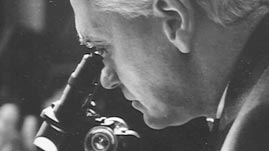Teachers' Domain - Digital Media for the Classroom and Professional Development
User: Preview


Source: A Science Odyssey: “Matters of Life and Death”


Funding for the development of this video segment on Teachers' Domain was provided by the Science Education for Public Understanding Program at the Lawrence Hall of Science.
In this video segment adapted from A Science Odyssey, learn what led British researcher Alexander Fleming to the chance discovery of antibacterial properties of a mold extract he later named penicillin. After treating World War I battlefield casualties, Fleming began searching for compounds that would ward off infections in humans. Returning from vacation in the summer of 1928, he noticed that mold was partly covering one of the agar plates in which he had been growing bacteria, and that the mold inhibited bacterial cell growth. Fleming determined that the mold possessed properties that could kill bacteria cells without harming human blood cells.
In 1928, British researcher Alexander Fleming unexpectedly discovered penicillin, the active ingredient in a mold that has potent infection-fighting abilities. At the time, Fleming determined that the penicillin was too unstable to work with. However, within 10 years, the Oxford team of Howard Florey and Ernst Chain was able to successfully purify a form of penicillin in sufficient concentration to offer therapeutic value in the treatment of human disease. With the help of the British government, Florey and Chain used a beer-brewing technology to produce the quantities of moldy liquor needed for large-scale penicillin production. When demand outstripped their production capacity, Florey went to the United States to establish mass-production agreements with U.S. pharmaceutical companies.
On the World War II battlefield, penicillin helped wounded soldiers stave off fatal infections. Off the battlefield, the drug helped defeat many ailments that had tormented civilization through the ages, including syphilis, gangrene, scarlet fever, and tuberculosis. Penicillin was the first antibiotic to be used to treat or cure disease.
Antibiotics help the body fight bacterial infections by interfering in the development of the bacteria's cell wall. Penicillin does not harm cell walls already made. But it does affect newly forming cells created through binary fission during cell reproduction. Cell walls are incredibly strong because long polymer strings are cross-connected with one another and held together with a special enzyme called transpeptidase. Penicillin blocks this enzyme from acting. While the long polymer strings will still be made, they cannot be cross-connected to one another when penicillin is present. This results in a cell wall that is very weak in spots, and is unable to contain the growth of the cell membrane. Without a rigid cell wall to constrain its growth, a bacteria cell continues to grow until its outer membrane stretches and ruptures, killing the cell.
Humans and other animals do not have cell walls, so penicillin is not harmful to human or animal cells. For the same reason, antibiotics are not effective in the treatment of viral infections. However, a few types of bacteria lack cell walls. These bacteria are immune to antibiotics like penicillin for the same reasons humans and animals are. And because humans have used penicillin so often since its discovery, there are many strains of bacteria that do have cell walls but have developed a resistance to it. Through natural selection, these species have effectively changed their wall-building systems so that penicillin has no effect.
 Loading Standards
Loading Standards Teachers' Domain is proud to be a Pathways portal to the National Science Digital Library.
Teachers' Domain is proud to be a Pathways portal to the National Science Digital Library.
